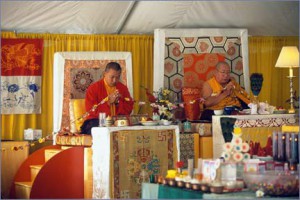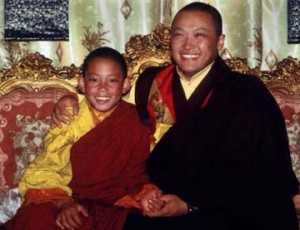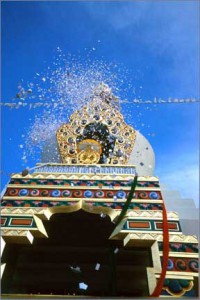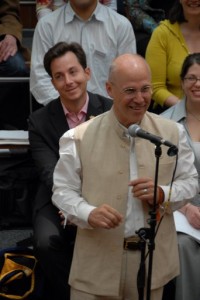Wednesday
Featured Stories, Sakyong and FamilyTWENTY YEARS OF RULING AND TEACHING: Part Three – Consecration

Sakyong Mipham and Penor Rinpoche during consecration of the Great Stupa of Dharmakaya. Photo courtesy of Shambhala Mountain Center.
By Shastri Benoît Côté
At some point during those years, Rinpoche started talking about a general public book on shamatha. The concept was something like an “airport book,” a book that somebody could be attracted to pick up while waiting for the next flight. A publisher from the Penguin Putnam organization was approached and they were definitively interested. But there was a slight problem. Rinpoche had dictated a manuscript of over 1000 pages, and they would not even look at something over 200 to 300 pages. Several people tried to work on that manuscript and the whole thing got stuck. Eventually Emily Sell was approached. She had worked for Shambhala Publications for many years, editing in particular Pema Chödrön’s books. She became the Sakyong’s personal editor, and the result was Turning the Mind Into an Ally which came out in 2003 and became a bestseller in its category.
Turning the Mind Into an Ally is the basic meditation manual that we use now with beginners. The first half is about shamatha, or “peaceful abiding.” For somebody familiar with the 1999 and 2000 transcripts, it is quite amazing to see how much of these teachings are presented here in a very simple and straightforward way. The second half is about vipashyana, “insight.” The turning point is chapter 12, called “Turning the Mind.”
The Buddha taught that to wake up from the dream of bewilderment and suffering, we first need to sit still and take a deep breath. Peaceful abiding is that deep breath, a way to strip away the chaos of bewilderment and find some basic sanity. But peaceful abiding is only the beginning of the spiritual journey. Simply withdrawing into the stability of our own minds could turn meditation practice into just another way to shop for pleasure. Instead, with this healthy sense of self we can look more deeply into the meaning of our being. We can take meditation further by using insight to reflect accurately on our own experience and on the nature of existence. We can point our mind in a new direction – away from illusions and toward reality. We do this through the practice of contemplation.
Finally some of these long talks that he gave at 1999 and 2000 seminaries found their way to a very large public and form the basis of how we introduce people to meditation practice. Students start with the basic peaceful abiding instruction of following the breath, but soon they are encouraged to include contemplations into their practice. In the Sakyong’s approach, that is the way to bring view into meditation practice and also into daily life.
In February 2001, he wrote a contemplative practice called “Arousing the Motivation for True Freedom from Samsara. ,”It was published as a little booklet with a red cover. It is about the commitment to the Buddha, the dharma, and the sangha, referred to as the three jewels. There is a ceremony called “Taking the Refuge Vow” which is the formal entrance into the buddhist path. By writing this practice, Rinpoche stressed that this is not just a once in a lifetime event, but could become a daily practice. The text is particular in many ways. It is not just a statement of the hinayana teachings. It is a full mahayana and Shambhala view of taking refuge. It includes a front visualization of a golden Shakyamuni Buddha, and a vivid description of each of the objects of refuge. It ends with:
Taking refuge in the three jewels is the basis upon which I enter the path of the middle way and see the intrinsic emptiness of all phenomena. Taking refuge allows me to delve into buddha nature wholeheartedly and to see the luminosity of all appearances. Thus, taking refuge is the basis for all accomplishment. (…)
When I do so, I can joyously proclaim that I am a child of the Buddha, a student of the dharma, a friend of the sangha, and a warrior of Shambhala.

The Sakyong Meeting the Twelfth Trungpa at Surmang Monastery in 2001. Photo courtesy of the Konchok Foundation.
From June 6 to July 17, 2001, Sakyong Mipham Rinpoche went for his first trip to Tibet. The purpose of the journey was to visit the Surmang monasteries, home to the Vidyadhara Chögyam Trungpa Rinpoche, and the Golok region, where some descendants of the family of the previous Mipham still live. At Surmang, he met with the then twelve-year-old Chökyi Senge, the Twelfth Trungpa Tulku. It is said that their connection was immediate. During this trip, he performed the Sadhana of Mahamudra abhisheka several times, once to a crowd of over 3000 people. In Golok, he was honored by officials, lamas and family descendants as the reincarnation of Mipham the Great and was given relics and objects that belonged to his predecessor. Among these was the personal seal. In August, a few weeks after returning from his trip, the Sakyong used this seal for the first time on the text of a Manjushri practice that he wrote, “The Wheel of Wisdom.” Mipham the Great was considered as an emanation of Manjushri. As part of the commentary to that practice, the Sakyong wrote:
The point of any meditation is to develop wisdom. It is wisdom that allows us to achieve enlightenment. At the heart of any practice, we are becoming more and more familiar with wisdom. Manjushri is that wisdom. Wisdom is how we rule our world. When we embody wisdom, we are jampal – the Tibetan word for Manjushri – gentle and glorious. Thus when we embody wisdom, we become glorious and gentle. Shambhala is a society where people are gentle and glorious, and thus wise. The Rigdens are an embodiment of Manjushri.
Later that month, he presided over the consecration of the Great Stupa of Dharmakaya at Shambhala Mountain Center. That was one of the most significant events organized by the sangha since the Sakyong’s empowerment. The magnificent structure that holds the relics of the Vidyadhara had been under construction for fourteen years. It was the largest and most complex project that the Shambhala sangha had ever undertaken. For many people, the consecration of the Stupa had also a sense of transition. It meant that the passing away of the Great Vidyadhara Chökyi Gyatso had been properly acknowledged, and it was time to move the energy forward. The overall coordinator for the consecration ceremonies was the then Director of the London Shambhala Centre, Richard Reoch.
Among the artifacts sold at the occasion of the consecration of the Great Stupa in 2001 was a beautiful one-hundred-and-eight page richly illustrated booklet that included two CDs with songs from famous artists including Sting, Joni Mitchell, Leonard Cohen, Willie Nelson as well as sangha artists like Bill Douglas, David Nichtern, Jerry Granelli, Beausoleil, and Allen Ginsberg. Track 14 of CD 1 is a poem called “A Lightning Bolt of Wisdom” read aloud, within a beautiful musical environment, by Sakyong Mipham Rinpoche. That was the beginning of a collaboration with the German producer and sangha member Felix Magnus that resulted in several “spoken word” recordings including “What About Me” and “Come and Dance.” Some of these have been turned into videos that found their way onto YouTube, and eventually put into an album called Mipham that came out in 2005.
The poetic expression of the Sakyong was already known within the sangha. He had published Smile of the Tiger, in 1998, and Snow Lion’s Delight came out in 2005. In her introduction, Anne Waldman wrote:
“Pick up your pots and pans/ Grab that meditation belt and walk this path,” Sakyong Mipham Rinpoche cheerfully extols us in Snow Lion’s Delight, a garland of 108 realization poems that examine the naïve mind as it self-consciously experiences itself growing to greater insight and delight.
Gradually in those years, an astonishing change happened. The sturdy earthy-looking Tibetan turned into a slim athletic-looking jogger. In his early forties, Sakyong Mipham Rinpoche changed his diet and started running, which led to his training to become an ardent marathon runner. And he did run a number of marathons throughout the world, using this occasion for raising money for the Konchok Foundation, which he had founded to help the people of eastern Tibet, in particular to build a shedra at Surmang Monastery and to help with the education of the Twelfth Trungpa. It was named after the Sakyong’s mother Lady Konchok Palden. That was another of these activities that started making him more visible in the media.
* * * * *
The first one-month Vajrayana Seminary occurred at Shambhala Mountain Center in the summer of 2002. A few Sutrayana Seminaries had already happened at that point. The three-month seminary had always been the gate to enter into vajrayana practices. The way it was done was that the students would get vajrayana transmission at the end of seminary, and would have to come back later to a regional centre in order to be introduced to ngöndro, or “preliminary practices.” This time, Rinpoche gave the transmission at the end of the first week and one of the main aspects of Vajrayana Seminary became the actual introduction to ngöndro. People would have the occasion to become familiar with this sometime challenging practice within the environment of seminary and the presence of the guru. That year he also started giving systematic commentary on each part of ngöndro practice, which he completed later in the fall at a Vajra Assembly at Karmê Chöling. Some of these teachings, as well as others that he gave further at other seminaries, were published in 2008 as the book Adhishthana, The View and Practice of Ngöndro.
On 6 October 2002, Sakyong Mipham Rinpoche took a new step in his reorganization of the community. He decided to appoint a President of Shambhala. This position had previously been held by his father, the Vajra Regent and himself. He now decided to establish this role as a separate position. He selected Richard Reoch, a Canadian who had previously been the Director of the London Shambhala Centre, the Sakyong’s Secretary in Europe, and director of the Stupa consecration. He told the new president: “If you take care of the organization, I will get on with the magic.” Simultaneously with making this appointment, he asked that a Shambhala Congress be convened – thus taking steps to strengthen both the centre of the mandala and the entire community.
In March 2003, came out another of these visionary ruling statements called “Treatise on Society and Organization.” It took the form of a letter to President Richard Reoch. It is about the interplay between Shambhala as an organization and as a society. It starts with a basic statement on society:
The basis of Shambhala society is exemplified by the word sangha, or gendun, “those who follow virtue.” The magical element that binds the words “society” and “enlightenment” into “enlightened society” is the wholehearted motivation by individuals to engage personally in a social transformation that will lead to the betterment of the society. Thus we are keen on the meaning that is hidden within the word “enlightenment”: to cleanse and purify, to generate and increase. Generating enlightened society begins with the willingness of individuals to look at their own habitual tendencies and take responsibility – first for purifying and cleansing their own outlook and action, and then for generating views and activities that are courageous and liberating. (…) Doing this will help us activate the compassion and wisdom necessary to lead a truly joyous and meaningful life.
Then the text refers to “many issues that we need to face from a societal point of view.” There is the “need to move in a direction where members feel supported” and the issue that “some people feel left out because they don’t have an active role in the organization.” He also discusses the “need to develop the organization to function as a support for a community that is building a society” and “welcome newcomers to Shambhala society with the proper approach, understanding, and attitude.” The Sakyong then talks about the teachings on natural hierarchy and offers the following metaphor:
When it rains, you don’t ask the clouds how to grow vegetables. You take the water and you grow vegetables. This is the notion of society. The role of the Sakyong is to provide space, to protect the space, so that flowers can blossom. The sun does not pull the flowers up to the sky; the flowers grow, reaching toward the heaven. If heaven is too close, the flowers will not exert themselves. Therefore the organization is necessary as the extension of the Sakyong’s ability to provide and protect space.
Later that year, in November, President Reoch was instrumental in organizing the first Shambhala Congress. Over 220 participants from North America, Latin America and Europe gathered in Halifax for five days of practicing and connecting, discussions and celebration. The “organization” started reaching another level of networking, articulation of governance, and clarification of big issues. The Sakyong was present at different moments, in particular at a morning session where he accepted to answer any question people had, including some challenging openly the evolution toward Shambhala Buddhism. From then on, there would be such a Congress every two years, with a Mandala Council meeting in the intervening years.



















